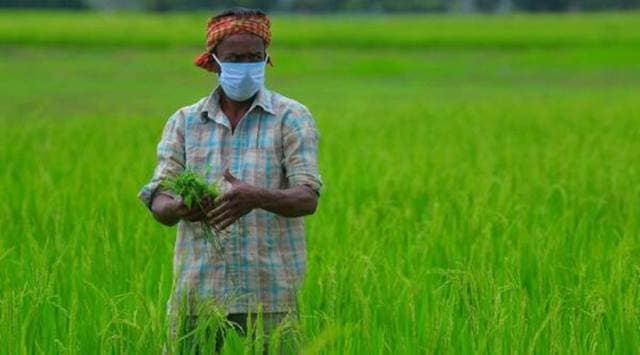- India
- International
For farmers, agency means choice
Expanding the range of choices available to the farmer on when, where, and at what price to sell, should be part of the ongoing discussions on farm laws.
 Under the new Act, a few private players who are going to dominate in the market will be free to frame their own rules regarding their procurement decisions from individual farmers.
Under the new Act, a few private players who are going to dominate in the market will be free to frame their own rules regarding their procurement decisions from individual farmers.Written by Vikas Birhma
India’s 150 million farmers are a diverse community. When a farmer tries to sell his harvest, multiple factors like proximity to APMC mandis, landholding, caste, gender, and access to credit, intersect to create a unique set of opportunities and challenges. This intersectionality makes farmer-level trade very complex. The current agri-mandi system does not provide many choices for the farmers to maximise their return on the harvest. The three new laws that open up the agri-market for farmgate trade and contractual farming might create a choice basket for farmers. However, they fall short of envisioning an ecosystem where farmers have the agency to benefit from these new choices. If the old needs to go, and the new is not good enough, then what is the possible way forward?
Post-harvest, farmers make three major decisions — when to sell, where to sell, and at what price. The first node of choice happens right after harvesting the crop when a farmer has two choices — either sell immediately or wait to sell later when prices turn favourable. The majority of farmers, especially the small and marginal, face a cash crunch around harvesting and choose to sell immediately. They lack the agency to hold the harvest to sell it later.
The second node of choice is where to sell. Here a farmer has two choices — sell at the mandi or sell at the farmgate. If the mandi is at a distance from the farmgate, it doesn’t make economic sense for small farmers to go to the mandi. It is a commonly known fact that most marginal farmers sell their produce to village-level traders outside of mandi areas. In addition, if a farmer has taken informal credit from a trader, then he has no choice but to sell the produce to the trader at a price offered by him.
The third node of choice is to either accept or reject the buyer’s offered price. If the farmer is selling in a mandi, it is practically impossible to decline the price got in the auction as he has already spent a lot of money and time to bring the produce to the mandi. Any decision to reject the offered price means further expenditure to take the crop back home and come again. When the farmer is selling at the farmgate, he cannot negotiate or reject because there is information asymmetry. The farmer doesn’t know the exact quality of the produce and the accurate spot market price of that day.

A farmer’s journey through these nodes tells us that currently, the farmer has neither choice nor agency; the sale decisions are mostly dependent on external variables. So, how can we build farmers’ choices and agency? Our organisation designs and prototypes marketing solutions for smallholder farmers. We did two experiments that can throw some light on increasing both choice and agency of farmers.
In our first experiment, we provided a warehouse-based integrated digital marketplace facility to farmers in the Yavatmal district, Maharashtra. Once a farmer stored the produce at the warehouse, it was converted into digital shares. The farmer can take credit against the stored produce, sell it in parts or in full from the comfort of his home using a simple SMS based phone.
In India, we have a mature agri-warehouse-finance industry that provides similar services to traders and agri-industries. But, they have not adapted themselves to deliver services to smallholder farmers. Then, the question is how to scale this warehouse based digital marketplace to over 150 million farmers.
One possible way is that existing mandis stop physical auctioning and enter into a public-private partnership to build storage infrastructure to support the digital marketplace. The market committee can provide oversight on quality inspection, trade agreements, and can act as a first-level grievance redressal authority.
This arrangement will create a win-win situation for farmers and the agriculture sector. Farmers will have a real choice of selling their crops to buyers from anywhere in India. Also, farmers will have the agency to reject the offered price if it is low and keep storing the produce to sell it later digitally from their homes. With new revenue streams and changed roles, the mandis, instead of losing their relevance, will act as the lynchpin of agriculture reforms. The government can subsidise warehouse rent and interest on credit to safeguard farmers from market volatility. This will be a far more equitable and efficient method than guaranteeing MSP for all the crops.
In our second experiment, we worked with farmers in the Chhindwara district, Madhya Pradesh, and tried to solve the information gap that exists between farmers and buyers during the farmgate sale. Currently, a farmer has no option other than to accept the buyers’ judgement on the crop’s quality and agreeing to the offered price. To change this, we designed a portable crop quality inspection kit and trained rural women and youth to deliver doorstep quality inspection services to farmers.
Using the farmers’ location and quality reports, we sent personalised price information to farmers every day. This quality and price information provided farmers with the agency to negotiate with buyers and receive a fair price. The fact that farmers are paying Rs 100 for quality and price information indicates their importance in building farmers’ agency at the farmgate sale.
Unfortunately, nowhere in India, farmers have access to independent quality inspection labs. Thus, the question remains the same — how to scale quality inspection services to reach 150 million farmers’ doorsteps. A possible pathway is to make crop quality inspection a part of skill development programmes and train hundreds of thousands of SHG women and youth in crop quality inspection. This will build farmers’ negotiating power and create lakhs of employment in rural India.
Is increasing farmers’ choices and agency inside and outside of mandi part of the ongoing negotiation? Sadly no.
There are hundreds of experiments happening across the country by FPOs, start-ups, and NGOs that can provide insights into building farmers’ choices and agency. If the government and farmers’ bodies want to improve farmers’ wellbeing, they need to build consensus around scaling solutions that promote farmers’ choices and agency. If we don’t do it now, both farmers and the agriculture sector stand to lose in the long run, and it will be a failure of our collective imagination.
The writer is co-founder and CEO of Gramhal
EXPRESS OPINION
Apr 25: Latest News
- 01
- 02
- 03
- 04
- 05










































